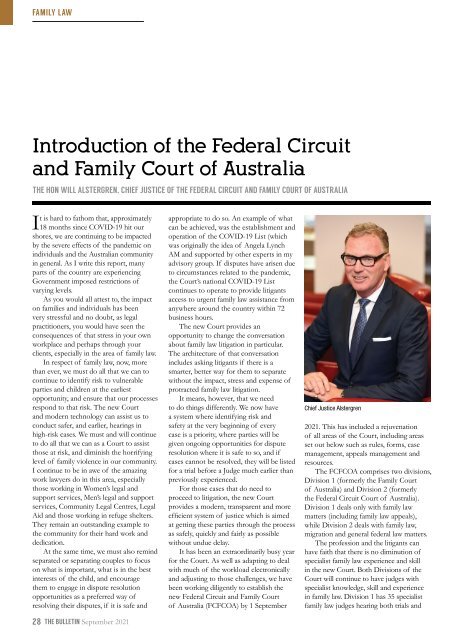LSB September 2021 LR
You also want an ePaper? Increase the reach of your titles
YUMPU automatically turns print PDFs into web optimized ePapers that Google loves.
FAMILY LAW<br />
Introduction of the Federal Circuit<br />
and Family Court of Australia<br />
THE HON WILL ALSTERGREN, CHIEF JUSTICE OF THE FEDERAL CIRCUIT AND FAMILY COURT OF AUSTRALIA<br />
It is hard to fathom that, approximately<br />
18 months since COVID-19 hit our<br />
shores, we are continuing to be impacted<br />
by the severe effects of the pandemic on<br />
individuals and the Australian community<br />
in general. As I write this report, many<br />
parts of the country are experiencing<br />
Government imposed restrictions of<br />
varying levels.<br />
As you would all attest to, the impact<br />
on families and individuals has been<br />
very stressful and no doubt, as legal<br />
practitioners, you would have seen the<br />
consequences of that stress in your own<br />
workplace and perhaps through your<br />
clients, especially in the area of family law.<br />
In respect of family law, now, more<br />
than ever, we must do all that we can to<br />
continue to identify risk to vulnerable<br />
parties and children at the earliest<br />
opportunity, and ensure that our processes<br />
respond to that risk. The new Court<br />
and modern technology can assist us to<br />
conduct safer, and earlier, hearings in<br />
high-risk cases. We must and will continue<br />
to do all that we can as a Court to assist<br />
those at risk, and diminish the horrifying<br />
level of family violence in our community.<br />
I continue to be in awe of the amazing<br />
work lawyers do in this area, especially<br />
those working in Women’s legal and<br />
support services, Men’s legal and support<br />
services, Community Legal Centres, Legal<br />
Aid and those working in refuge shelters.<br />
They remain an outstanding example to<br />
the community for their hard work and<br />
dedication.<br />
At the same time, we must also remind<br />
separated or separating couples to focus<br />
on what is important, what is in the best<br />
interests of the child, and encourage<br />
them to engage in dispute resolution<br />
opportunities as a preferred way of<br />
resolving their disputes, if it is safe and<br />
28 THE BULLETIN <strong>September</strong> <strong>2021</strong><br />
appropriate to do so. An example of what<br />
can be achieved, was the establishment and<br />
operation of the COVID-19 List (which<br />
was originally the idea of Angela Lynch<br />
AM and supported by other experts in my<br />
advisory group. If disputes have arisen due<br />
to circumstances related to the pandemic,<br />
the Court’s national COVID-19 List<br />
continues to operate to provide litigants<br />
access to urgent family law assistance from<br />
anywhere around the country within 72<br />
business hours.<br />
The new Court provides an<br />
opportunity to change the conversation<br />
about family law litigation in particular.<br />
The architecture of that conversation<br />
includes asking litigants if there is a<br />
smarter, better way for them to separate<br />
without the impact, stress and expense of<br />
protracted family law litigation.<br />
It means, however, that we need<br />
to do things differently. We now have<br />
a system where identifying risk and<br />
safety at the very beginning of every<br />
case is a priority, where parties will be<br />
given ongoing opportunities for dispute<br />
resolution where it is safe to so, and if<br />
cases cannot be resolved, they will be listed<br />
for a trial before a Judge much earlier than<br />
previously experienced.<br />
For those cases that do need to<br />
proceed to litigation, the new Court<br />
provides a modern, transparent and more<br />
efficient system of justice which is aimed<br />
at getting these parties through the process<br />
as safely, quickly and fairly as possible<br />
without undue delay.<br />
It has been an extraordinarily busy year<br />
for the Court. As well as adapting to deal<br />
with much of the workload electronically<br />
and adjusting to those challenges, we have<br />
been working diligently to establish the<br />
new Federal Circuit and Family Court<br />
of Australia (FCFCOA) by 1 <strong>September</strong><br />
Chief Justice Alstergren<br />
<strong>2021</strong>. This has included a rejuvenation<br />
of all areas of the Court, including areas<br />
set out below such as rules, forms, case<br />
management, appeals management and<br />
resources.<br />
The FCFCOA comprises two divisions,<br />
Division 1 (formerly the Family Court<br />
of Australia) and Division 2 (formerly<br />
the Federal Circuit Court of Australia).<br />
Division 1 deals only with family law<br />
matters (including family law appeals),<br />
while Division 2 deals with family law,<br />
migration and general federal law matters.<br />
The profession and the litigants can<br />
have faith that there is no diminution of<br />
specialist family law experience and skill<br />
in the new Court. Both Divisions of the<br />
Court will continue to have judges with<br />
specialist knowledge, skill and experience<br />
in family law. Division 1 has 35 specialist<br />
family law judges hearing both trials and


















